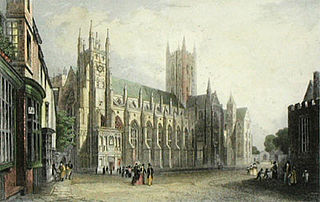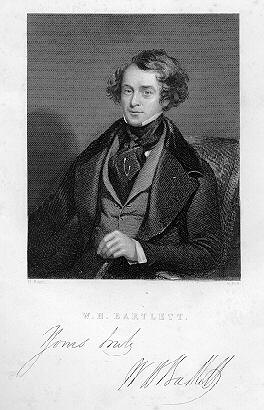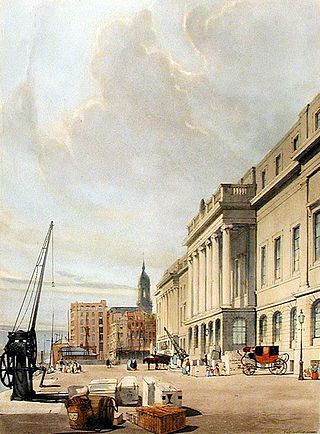
William Tombleson (1795 - c. 1846) was an English topographical and architecture artist, illustrator, copper and steel engraver, writer and printmaker, based in London. [1]

William Tombleson (1795 - c. 1846) was an English topographical and architecture artist, illustrator, copper and steel engraver, writer and printmaker, based in London. [1]
In the 1830s, his topographical drawings of the upper and middle River Rhine in Germany, and of the rivers Thames and Medway in England were published as engraved prints and books (see bibliography). For volume 1 of "Views of the Rhine etc." he provided 69 illustrations - the book was also published in French and German editions.
Engravers who worked on Tombleson's drawings included Thomas Clark, John Cleghorn, T. Cox, R. Harris, W. Hood, J. Howe, W. Lacey, O. Smith, Shenfield, J. Stokes, D. Thompson, W. Tombleson, W. Watts, R. Wilson, H. Winkles and others.
Illustrated by Tombleson:
Books with engravings by Tombleson:
William Finden was an English engraver.

Thomas Mann Baynes (1794–1876) was an English artist and lithographer. He is known for his drawings and watercolours of landscapes, buildings and outdoor events.

Henry Thomas Ryall was an English line, stipple and mixed-method engraver and later used mixed mezzotint.

Thomas Allom was an English architect, artist, and topographical illustrator. He was a founding member of what became the Royal Institute of British Architects (RIBA). He designed many buildings in London, including the Church of St Peter's and parts of the elegant Ladbroke Estate in Notting Hill. He also worked with Sir Charles Barry on numerous projects, most notably the Houses of Parliament, and is also known for his numerous topographical works, such as Constantinople and the Scenery of the Seven Churches of Asia Minor, published in 1838, and China Illustrated, published in 1845.

William Henry Bartlett was a British artist, best known for his numerous drawings rendered into steel engravings.
William Holl the Younger was a British portrait and figure engraver, noted for his book illustrations.

Storrs Hall is a hotel on the banks of Windermere in Storrs in the Lake District, Cumbria, England. The hotel, a Grade II* listed Georgian mansion, is also home to the National Trust-owned folly the "Temple" on the end of a stone jetty on Windermere. Situated in the Lake District, Storrs Hall sits alongside the Windermere.

John Cochran or Cochrane was a Scottish portrait miniaturist, a stipple and line engraver and a painter of watercolours. Cochran exhibited his portraits at the Royal Academy between 1821 and 1823, and at the Suffolk Street Gallery from 1821 to 1827.
James Baylis Allen (1803–1876) was a British engraver. Allen, together with Edward and William Radclyffe and the Willmores, belonged to a school of landscape-engravers which arose in Birmingham, where there were numerous engravers working on iron and steel manufactures.

Robert Brandard was a British landscape engraver and landscapist.

Thomas Shotter Boys (1803–1874) was an English watercolour painter and lithographer.
Edward Francis Finden (1791–1857) was a British engraver.
William Thomas Fry (1789–1843) was a British engraver. He occasionally exhibited his engravings at the Suffolk Street exhibition.

John Henry Robinson (1796–1871) was an English engraver.

James Thomson (1788–1850) was a British engraver, known for his portraits. He completed his apprenticeship in engraving and then established himself independently, following the dot and stipple style. His engravings and paintings featured both leading figures of his day and those of previous periods.
Charles Fox (1794–1849) was an English engraver.
Edward Goodall was a British engraver. He is now best known for his plates after J. M. W. Turner.

Joseph John Jenkins was a British engraver and watercolor painter. He is best known for his portraits and landscapes paintings.
Thomas Alfred Woolnoth (1785–1857) was an English engraver. He was known for his portraits of theatre people. He also painted, and engraved works of Correggio and Van Dyck. Woolnoth was engraver to Queen Victoria. His work was also included in Cadell and Davies Britannia depicta.

William Woolnoth (1780–1837) was an engraver. He was one of the engravers whose work was included in Cadell and Davies Britannia depicta. He did engravings of work by artists such as Thomas Mann Baynes, Robert Blemmell Schnebbelie, Frederick Wilton Litchfield Stockdale and Thomas Allom. He also did the engravings for Edward William Brayley's The ancient castles of England and Wales. He did the engravings for a book that he published in 1816 on the cathedral church of Canterbury According to Oxford Reference he also did engraving work in Spain. He was also one of the engravers for The Architecture of M. Vitruvius Pollio in Ten Books.